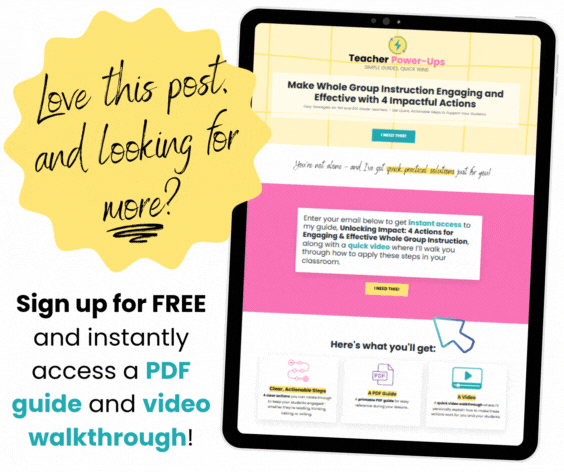Let’s be real—whole group instruction can be tough. Teaching a room full of 4th or 5th graders with different skills, attention spans, and motivation levels is no small feat.
But whole group time is also incredibly important, so we’ve got to make it work.
Over the years, I found that focusing on four key actions helped me keep my students engaged and make the most of our time together.
These actions are simple (trust me), but when you use them intentionally, they can completely transform your whole group lessons.
If you want a video walkthrough and a quick one-page cheat sheet that explains these four actions step by step, you can grab them here.
Let’s dive in!
Start With These Four Actions
The key to keeping whole group instruction effective and engaging is to make sure students are always doing one or more of these four things: reading, thinking, talking, or writing.
Here’s how I break it down:
Reading
Whenever possible, I make sure my students have a copy of the text in front of them. Having them actively follow along with the text keeps them engaged and accountable, no matter their reading level.
If giving students their own copy isn’t possible, don’t worry! That’s where the next action—thinking—comes in.
Thinking
I love embedding quick, focused questions throughout my lessons to keep students thinking about what we’re reading or discussing. These aren’t the heavy, higher-order questions we save for deeper analysis later.
These are quick prediction questions, connections, or simple retells that keep students engaged in the moment.
Think of this as the “stay with me” step—it’s about making sure everyone’s paying attention and processing the material as you go.
Talking
Giving students opportunities to talk about what they’re learning is a game-changer, but it works best when you keep it simple. I love strategies like:
- Letting students share their thoughts in pairs or triads before discussing as a class.
- Using sentence stems or sentence starters to guide their responses and keep conversations focused. For example, you might ask, “What motivated the character to do this?” and give them a sentence starter like, “The character was motivated by…” to help them get started.
Writing
Writing can be as simple as jotting ideas on a sticky note or as detailed as filling out a graphic organizer that leads to an extended response. The goal is to get students engaging with the content through writing, but it doesn’t always have to be lengthy or formal.
My rule of thumb is:
If your lesson is focused on comprehension, keep the writing short and sweet.
If the goal is improving writing skills, spend more time on it—but make sure to scaffold the process so students feel successful.
How to Make It Work in Your Classroom
Not every lesson will include all four actions, and that’s okay.
Start with reading and thinking, then mix in talking or writing depending on what fits best with your students and the lesson.
Here’s what this might look like in action:
- Have students read a text (or listen as you read it aloud).
- Pause frequently to ask a quick question that gets them thinking.
- Let them turn and talk to a partner to share their answers.
- Wrap up by having them jot down their thoughts on a sticky note or in their notebook.
It doesn’t have to be complicated, but these small shifts can make a big difference in keeping your students engaged and focused.
A Few Bonus Tips
If you want to take this even further, here are some quick tips that worked wonders for me:
Marker boards are magic.
If your students aren’t responding well to notebooks or sticky notes, pull out the marker boards. They’re simple, low-prep, and students love them.
Keep partner talks structured.
Assign students as “Partner A” and “Partner B,” and give clear instructions about who talks first and who listens. This keeps discussions on track and avoids chaos.
It’s not about the location.
Whether you’re teaching on the carpet or at their desks, what matters most is using the four actions intentionally. The location doesn’t determine success—the structure and engagement do.
Make it easy for them to succeed.
Use sentence stems, provide checklists, and break tasks into manageable steps. The easier it is for students to participate, the more confident and engaged they’ll be.
Keep think time focused.
Give students enough time to process your questions, but not so much that they lose focus. Finding the right balance can take practice, but it’s worth it.
Ready to Make This Happen?
If you’d like a cheat sheet and a video walkthrough to help you implement these strategies, you can grab them here.
Whole group instruction doesn’t have to feel overwhelming. By embedding these four actions and focusing on what works best for your students, you can make this time more engaging and effective.








Leave a Comment